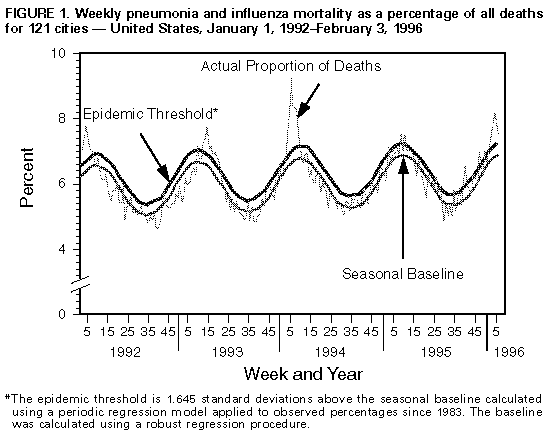 |
|
|
|
|
|
|
| ||||||||||
|
|
|
|
|
|
|
||||
| ||||||||||
|
|
|
|
|
Persons using assistive technology might not be able to fully access information in this file. For assistance, please send e-mail to: mmwrq@cdc.gov. Type 508 Accommodation and the title of the report in the subject line of e-mail. Update: Influenza Activity -- United States, 1995-96 SeasonInfluenza activity in the United States increased from late October through mid- to late December 1995. Although activity began to decline during January 1996, for the week ending February 3, a total of 19 states reported continuing regional or widespread activity *. Influenza type A(H1N1) predominated in all regions except the Mountain, Pacific, and New England regions, where type A(H3N2) predominated. Influenza type B accounted for only 1% of all isolates nationwide. As of February 3, 1996, of the 19,520 specimens submitted to World Health Organization collaborating laboratories in the United States for respiratory virus testing, 2965 (15%) have been positive for influenza virus: 2925 (99%) were influenza type A, and 40 (1%) were influenza type B. Of the 1803 type A isolates that have been subtyped, 1188 (66%) were type A(H1N1) and 615 (34%) were type A(H3N2). In six of the nine regions in the United States, influenza type A(H1N1) has accounted for from 64% to 89% of subtyped influenza type A strains. In the Mountain, Pacific, and New England regions, influenza type A(H1N1) has circulated at lower levels, accounting for 41%, 46%, and 48% of subtyped influenza A strains, respectively. Regional influenza activity was first reported the week ending October 28, 1995. The number of states reporting regional or widespread activity increased each week from November 5 through December 23, 1995, peaking at 35 states the first week of January 1996. Most outbreaks reported by states to CDC were among school-aged children. Some outbreaks among elderly persons in nursing homes also were reported. The proportion of patients with influenza-like illness (ILI) who visited 150 U.S. sentinel physicians began to increase the week ending December 16; this increase continued through December, with a peak of 7% of total office visits during the week ending December 30. During January, the proportion of patients with ILI began to decline, reaching 3% by the week ending January 20. The proportion of deaths attributed to pneumonia and influenza (P&I) reported from 121 U.S. cities exceeded the epidemic threshold ** by a small margin during three of the eight weeks from October 29 through December 23, 1995. The proportion of P&I deaths increased from the week ending December 30 through the week ending January 20 and began to decline the week ending January 27, but remained above the epidemic threshold (Figure_1). Reported by: Participating state and territorial epidemiologists and state public health laboratory directors. World Health Organization collaborating laboratories. Sentinel Physicians Influenza Surveillance System of the American Academy of Family Physicians. Influenza Br and WHO Collaborating Center for Surveillance, Epidemiology, and Control of Influenza, Div of Viral and Rickettsial Diseases, National Center for Infectious Diseases, CDC. Editorial NoteEditorial Note: Although influenza activity in the United States peaked during late December 1995, influenza viruses have continued to circulate through early February 1996. The occurrence of a high proportion of reported outbreaks among school-aged children is consistent with patterns during previous influenza seasons when type A(H1N1) viruses have predominated. Influenza A(H1N1) outbreaks among children and younger adults can be associated with high absenteeism in schools and workplaces, and severe secondary medical complications in a small proportion of infected persons. Surveillance findings this season suggest that the incidence of influenza among younger children is substantially higher than usual. Influenza type A(H1N1) has not predominated in the United States since the 1986-87 season, and has circulated at low levels since 1989. As a consequence, a high proportion of children born in the United States since the late 1980s would not be expected to have been exposed to type A(H1N1) viruses before this influenza season. Despite the ability of type A(H1N1) to cause widespread outbreaks, since 1977 -- when type A(H1N1) viruses reemerged after an absence of 20 years -- this strain has not been associated with substantial morbidity among older adults nor with excess mortality. In comparison, type A(H3N2) viruses, which emerged in 1968, more commonly have been associated with excess mortality, greater than 90% of which has occurred among persons aged greater than or equal to 65 years. Epidemics of influenza type B also have been associated with excess mortality (1,2). Although the contribution of type A(H1N1) and type A(H3N2) viruses to the excess P&I mortality this influenza season cannot be assessed precisely, observations during previous influenza seasons strongly suggest that most of these deaths were caused by type A(H3N2) viruses. References
** The epidemic threshold is 1.645 standard deviations above the seasonal baseline calculated using a periodic regression model applied to observed percentages since 1983. The baseline was calculated using a robust regression procedure. Figure_1  Return to top. Disclaimer All MMWR HTML versions of articles are electronic conversions from ASCII text into HTML. This conversion may have resulted in character translation or format errors in the HTML version. Users should not rely on this HTML document, but are referred to the electronic PDF version and/or the original MMWR paper copy for the official text, figures, and tables. An original paper copy of this issue can be obtained from the Superintendent of Documents, U.S. Government Printing Office (GPO), Washington, DC 20402-9371; telephone: (202) 512-1800. Contact GPO for current prices. **Questions or messages regarding errors in formatting should be addressed to mmwrq@cdc.gov.Page converted: 09/19/98 |
|||||||||
This page last reviewed 5/2/01
|